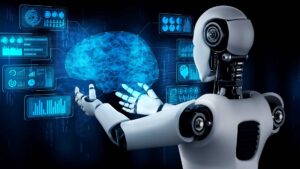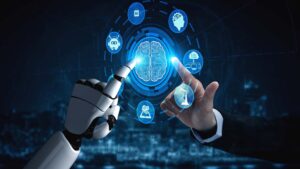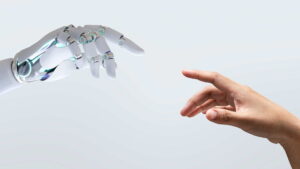The Human + AI model of work is best, based on the incredible concept of co-creation. Who would have thought ages ago that Artificial Intelligence would one day assist and facilitate humans in multiple useful ways?
It is now humanize AI future of work, innovation, and society in a cooperative way rather than a conflict between humans and AI. As AI develops further, it will enable us to achieve objectives that were unthinkable only a few decades ago. Collaboration between AI and humans opens up new possibilities, productivity, and innovation.
When we learn to incorporate AI into our lives as a necessary, moral, and helpful tool, the power of humans and AI will only become more obvious. We are at the beginning of a fascinating period in which we may utilize the greatest aspects of both artificial and human intelligence, rather than having to pick AI or human.
Nonetheless, In AI to human collaboration journey, artificial intelligence has evolved from an abstract idea to a practical instrument that is changing industries, streamlining processes, and igniting fresh discussions in recent years. Whether AI will be a difficult friend or a rival to humans is one of the most important topics of our day.

We may be approaching a new era of “Human + AI,” where AI enhances human capacity, creativity, and productivity, rather than viewing it as “Human vs. AI.” The truth is that when humans and AI collaborate, their abilities complement each other in ways that neither could accomplish on their own, producing the most effective outcomes.
With its ability to do jobs requiring pattern recognition, huge data processing, and predictive insights, artificial intelligence (AI) has already revolutionized several important industries.
However, AI lacks human intuition, emotional intelligence, creativity, and ethical reasoning, even though it can perform some tasks incredibly well. Because AI and humans both have unique strengths, they are better suited as collaborators than rivals. We can achieve remarkable results in a variety of sectors by combining human knowledge and understanding with AI’s computing capacity.
Why It should be “Human + AI,” than human vs. AI?

Strengths and Skills That Complement Each Other
AI is superior to humans in processing enormous volumes of data, identifying patterns, and predicting outcomes. However, AI cannot replace the creativity, strategic thinking, and adaptability that humans bring to the table. When combined, they produce a strong interaction humans make the complex, moral, and imaginative choices that give ideas life, while AI processes and filters information.
Enhancement Rather than Replacement
AI is made to manage repetitive jobs, evaluate information, and automate procedures that humans can find time-consuming. In Human-AI collaboration, Human minds may now concentrate on more complex activities that call for creativity, problem-solving, and a personal touch. In this way, humanize AI is enhancing human capabilities rather than taking the place of human tasks, enabling humans to create and perform at higher levels.
Quicker and Better Decision-Making
Decision-makers can make well-informed decisions because of AI’s real-time data analysis and presentation capabilities. AI, for instance, can quickly evaluate medical data in the healthcare industry, helping physicians make more accurate disease diagnoses. More effective, life-saving decisions are made when AI’s speed and precision are combined with human understanding and contextual knowledge. It is all about accepting what both can give and then excelling with the best combined Human-AI skills.
New Ideas and Prospects
Besides optimizing existing roles, the human + AI partnership is generating whole new industries and employment prospects. Whether it’s producing complicated designs, finding fresh scientific discoveries, or producing interactive digital art, AI-driven tools are assisting scientists, engineers, designers, and even artists in opening up new possibilities. This Human-AI partnership promotes innovation, opening doors for previously unheard-of sectors and jobs.
Examples of Successful Human + AI Collaboration

Healthcare in the Real World
AI-powered diagnostic technologies in the medical industry assist physicians by spotting trends in imaging scans and occasionally even detecting anomalies that could otherwise go undetected. But in ways AI alone could not, doctors provide individualized treatment by bringing contextual knowledge, ethical judgment, and patient empathy to the table.
Finance
Artificial intelligence (AI) enhances human knowledge in customer relationship management and strategic investment decision-making by analyzing financial patterns and detecting fraud. In Human + AI, The financial industry is changing as a result of the combination of AI-driven insights and human analysts, which enable efficiency and a degree of personalization that fosters trust.
Education
Students can receive individualized instruction from AI-powered educating and educational platforms, which give extra help outside of the classroom. After then, educators concentrate on the human element of learning, utilizing AI data to meet the requirements of individual students and offering them support and empathy that AI is unable to offer.
The Difficulties of Human-AI Cooperation

Collaboration between humans and AI has great promise, but there are drawbacks as well. For a successful collaboration, we need to carefully think about:
Morality and Responsibility
It’s serious to institute accountability since AI systems make judgments that have real-world consequences. Who makes the decisions for AI in the fields of justice, healthcare, and finance? To guarantee AI functions morally and in accordance with societal norms, humanize AI supervision is necessary.
Bias and Openness
Because AI models are trained on data, they may inherit biases from the training process or the data itself. AI systems need to be routinely audited by humans to ensure transparency and fairness. In Human + AI, Fairness and increased public trust will result from transparent communication between human and computer decision-making.
Skill and Flexibility
For human-AI cooperation to be successful, people must be able to use AI technologies efficiently. The workforce will be better equipped to adapt to and take advantage of AI if they have advanced their skills in digital literacy, AI ethics, and data analysis.
In Human + AI, each side brings something unique to the table. AI is at its best when it amplifies our strengths, filling in gaps while we do what only humans can do. Therefore, the future must not be about AI taking over; it should be about working together to solve problems faster and more creatively













